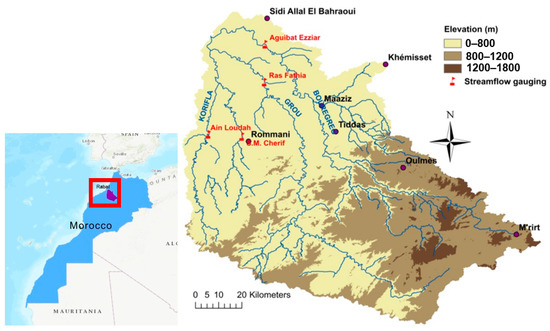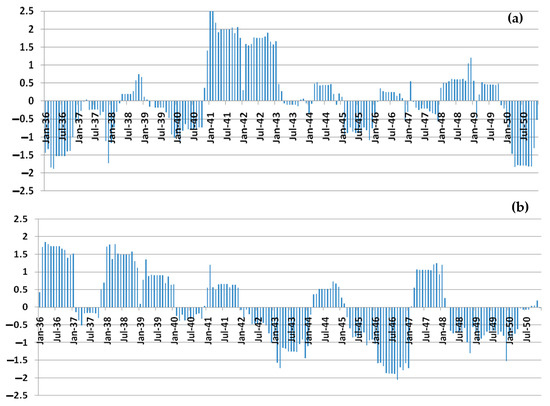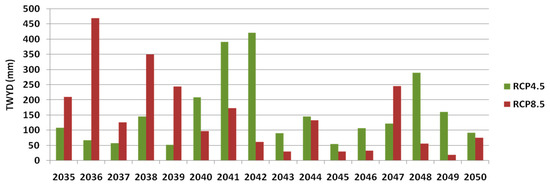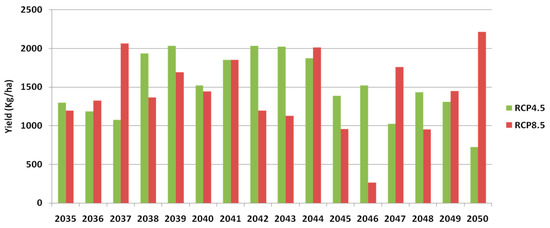Abstract
Improving the preparedness of agricultural systems to future climate-change-induced phenomena, such as drought-induced water stress, and the predictive analysis of their vulnerability is crucial. In this study, a hybrid modeling approach based on the SWAT model was built to understand the response of major crops and streamflow in the Bouregreg catchment in Morocco to future droughts. During dry years, the simulation results showed a dramatic decrease in water resources availability (up to −40%) with uneven impacts across the study catchment area. Crop-wise, significant decreases in rainfed wheat productivity (up to −55%) were simulated during future extremely dry growing seasons.
1. Introduction
At a global scale, the potential impact of climate change on major systems is an important question for decision makers, investors and farming communities. Water resources directly interfere with public health and safety, agriculture and food security, energy, industry, biodiversity and ecosystems and, thus, influence the socio-economic development of the nations. Water resources in Morocco are particularly vulnerable to human activities, such as increases in population, tourism, agricultural development and industrial growth being some examples of challenges faced by water resources in the country. In addition to these factors, the changing climate and all resulting phenomena (such as drought) represent a further threat that can have a significant impact on water resources in Morocco and all areas within a similar context. Farming activities are of crucial importance to the country, and are generally vulnerable to climate variability, which can affect the national economy in some situations. The objective of this study is to provide a representative case study of drought-induced water stress vulnerabilities and a catchment-scale impacts assessment in the future, with a focus on water and rainfed crop systems during dry years.
2. Material and Methods
2.1. Study Area
The study catchment area was Bouregreg, a 9656 km2 watershed located in the north-western part of Morocco; it is one of the most important watersheds in the country [1].
Essentially, there are different climatic zones in the study catchment area influenced by the ocean: subhumid in the extreme western part, semiarid in the central part and arid climate in the south-eastern [1]. The annual potential water resources of the Bouregreg watershed is 720 Million m3, coming mostly from surface water. The stream network of the Bouregreg catchment area is organized into 3 main rivers: Korifla, Grou and Bouregreg rivers (Figure 1) [1,2]. In terms of land use, oak forests cover approximately 24% of the total area of the study watershed; farming activity is very important (olive trees, pulse crops, wheat in addition to minor parcels where some irrigated vegetables and grape crops are grown). Range and pasture lands are distributed across the watershed [1,3].

Figure 1.
Location, topography and streamflow network of BW and the used gauging stations.
2.2. Models Presentation
For hydrological processes investigation, we used soil and water assessment tool (SWAT) model. SWAT is a hydrological model developed by the United States Department of Agriculture [4]. It simulates the cycle of water and sediments in large-scale watersheds and large basins with different soil types and management conditions; it also simulates the effect of agriculture practices, or any other anthropogenic actions that can affect water cycle [5,6]. Regarding drought analysis, interpolated rainfall outputs of SWAT over Bouregreg watershed were used to compute drought indicator such as the standardized precipitation index (SPI) along the study periods. In this study, SWAT model was run over the period of January 1990 to December 2005 (data collected from the local water department’s measurements); the first two years were allocated to warm up process, and the period of January 1992 to December 2001 was dedicated to model calibration. Validation was performed over the period January 2002 to December 2005 (due to the limited amount of measured data). Following sensitivity analysis, streamflow and crops yields were examined during the calibration process. A maximal agreement between observed and predicted processes was the ultimate goal.
In order to assess future climate projections in the study watershed, dynamically downscaled output data from the Global Climate Model CNRM-CM5 were used [7]. Two representative concentration pathways (RCPs) were selected, RCP4.5 and RCP8.5. Baseline time series for both daily temperature (max and min) and rainfall data were from January 1990 to December 2010; for future datasets, the 2030–2050 period was collected from the outputs of the Global Climate Model CNRM-CM5. The SPI is a statistical monthly indicator that compares the cumulated precipitation during a period of a number of months with long-term cumulated rainfall distribution for the same location and accumulation period [8]. In this work, SPI-12 was calculated using the 2018 Version of SPI Generator application [9] of the National Drought Management Centre (University of Nebraska, USA) [8]. Once a drought event was determined with its start and end month, its duration and magnitude were then assigned. The duration of a drought event was equal to the number of months between its start (included) and end months (not included); the drought magnitudes were calculated as the sums of the SPI values that were always negative over consecutive months, and the severity as the maximum SPI value of each episode.
3. Results
3.1. Future Droughts Analysis
Figure 2 represents the distribution of monthly SPI-12 values over the study periods in the Bouregreg watershed.

Figure 2.
Monthly distribution of SPI-12 values for (a) 2035–2050 period under RCP4.5 and (b) 2035–2050 period under RCP8.5.
According to the distribution of SPI-12 values, several drought events were expected (with different magnitudes and durations) under both scenarios. Both scenarios showed three drought classes (dry, severely dry and extremely dry) but with different durations and magnitudes.
3.2. Drought Impact on Water Availability
During the 2035 to 2050 period, several decreases in the annual total water yield (TWYD) occurred and are shown in Figure 3. Under RCP4.5, the expected drought episode of January 2036 to April could affect water resources in the study watershed during 2036 and 2037 (67 mm and 57 mm, respectively). During the same simulation period under RCP8.5, the drought period of October 2045 till February 2047 could reduce the TWYD averages in the watershed to 30 mm and 33 mm in 2045 and 2046, respectively.

Figure 3.
Distribution of annual TWYD averages under both RCPs over 2035–2050 period.
3.3. Future Crop Performance Analysis
Averages of wheat yields over the whole simulation periods were expected to decrease in most scenarios in comparison to the current one, but with a very high year-to-year variability (Figure 4).

Figure 4.
Annual yields averages of wheat crops (under both RCPs) over 2035–2050.
In Morocco, and more specifically in the Bouregreg watershed, wheat is sown in between autumn and winter, as most rain happens in wintertime, and temperatures are generally mild in this season. Early stress (excessive temperature and low soil moisture) (Figure 2) limits the tiller number (low ears per unit area) and later stress (after anthesis) can reduce the size of individual grains and their number [10].
4. Discussion
The projected droughts over the BW revealed that the watershed is likely to experience several droughts with different severity levels under both climate change scenarios. These results endorsed the findings of Gudmundsson and Seneviratne [11], since they reported that enhanced greenhouse forcing has contributed to increased drying in the Mediterranean region (including Northern Africa), and that this trend is likely to keep increasing over the century, especially under high levels of global warming.
5. Conclusions
The hydrology and agriculture of the Bouregreg watershed are presumed to experience significant impacts of climate-change-induced water stress; it is expected to have a high year-to-year water and crop yield variability due to several drought events with different severity levels. This context could lead to more challenging water resource situations in the watershed, mainly during the severe and long drought episodes.
Author Contributions
Conceptualization, Y.B.; methodology, Y.B., A.A., Y.E.-z.; writing—original draft, Y.B., O.A.; review and editing, L.B. (Lhoussaine Bouchaou); validation, A.C., L.B. (Lahcen Benaabidate) All authors have read and agreed to the published version of the manuscript.
Funding
This research received no external funding.
Institutional Review Board Statement
Not applicable.
Informed Consent Statement
Not applicable.
Data Availability Statement
Not applicable.
Conflicts of Interest
The authors declare no conflict of interest.
References
- ABHBC. Le Plan Directeur d’Amenagement Integré des Ressources en eau du Bassin Hydraulique du Bouregreg et de la Chaouia; Agence du Bassin Hydraulique du Bouregreg et de la Chaouia: Benslimane, Morocco, 2011.
- Belmatrik, S. Dispositif de Prevision des Risques de Crues; ABHBC: Benslimane, Morocco, 2010.
- Rahdou, M. Modelisation Hydrologique du Bassin Versant de Bouregreg (S.S) et Evaluation de Taux d’Envasement du Barrage Sidi Mohamed Ben Abdellah (Maroc) par la Methode Bathymetrique. Master’s Thesis, Faculty of Sciences and Techniques Fes, Fez, Morocco, 2010. [Google Scholar]
- Arnold, J.G.; Srinivasan, R.; Muttiah, R.S.; Williams, J.R. Large area hydrologic modeling and assessment—PartI. J. Am. Water Resour. Assoc. 1998, 34, 73–89. [Google Scholar] [CrossRef]
- Arnold, J.G.; Moriasi, D.N.; Gassman, P.; Abbaspour, K.C.; White, M.J.; Srinivasan, R.; Santhi, C.; Harmel, R.D.; Van Griensven, A.; Van Liew, M.W.; et al. SWAT: Model use, Calibration, and Validation. Am. Soc. Agric. Biol. Eng. 2012, 55, 1491–1508. [Google Scholar]
- Moriasi, D.N.; Arnold, G.J.; VanLiew, W.M.; Bingner, L.R.; Harmel, D.R.; Veith, L.T. Model Evaluation Guidelines for Systematic Quantification of Accuracy in Watershed Simulations. Trans. ASABE 2007, 50, 885–900. [Google Scholar] [CrossRef]
- Taylor, K.E.; Ronald, J.S.; Gerald, A.M. Overview of CMIP5 and the experiment design. Bull. Am. Meteorol. Soc. 2012, 93, 485–498. [Google Scholar] [CrossRef] [Green Version]
- McKee, T.B.; Doesken, N.J.; Kleist, J. The Relationship of Drought Frequency and Duration to Time Scales. In Proceedings of the 8th Conference on Applied Climatology, Anheim, CA, USA, 17–22 January 1993; pp. 179–184. [Google Scholar]
- NDMC. User Manual of: SPI Calculator. National Drought Mititgation Center—UNL. 2018. Available online: https://drought.unl.edu/monitoring/SPI/SPIProgram.aspx (accessed on 1 May 2022).
- Brouziyne, Y.; Abouabdillah, A.; Hirich, A.; Zaaboul, R.; Benaabidate, L. Modeling sustainable adaptation strategies toward a climate-smart agriculture in a Mediterranean watershed under projected climate change. Agric. Syst. 2018, 162, 154–163. [Google Scholar] [CrossRef]
- Gudmundsson, L.; Seneviratne, S.I. Anthropogenic climate change affects meteorological drought risk in Europe. Environ. Res. Lett. 2016, 11, 044005. [Google Scholar] [CrossRef]
Publisher’s Note: MDPI stays neutral with regard to jurisdictional claims in published maps and institutional affiliations. |
© 2022 by the authors. Licensee MDPI, Basel, Switzerland. This article is an open access article distributed under the terms and conditions of the Creative Commons Attribution (CC BY) license (https://creativecommons.org/licenses/by/4.0/).